
By Alessia Leibert
December 2013
With two-thirds of manufacturing vacancies in the state classified as hard to fill, employers are getting creative in their search for workers, including training new hires internally.
Hiring difficulties persist in the manufacturing sector. Based on results from the spring 2013 round of the Minnesota Hiring Difficulties Survey, two-thirds of the industry's positions were hard to fill, virtually unchanged from the 68 percent reported in spring 2012. Machinist jobs were the hardest positions to fill at 78 percent, followed by machine tool operators (see Figure 1).
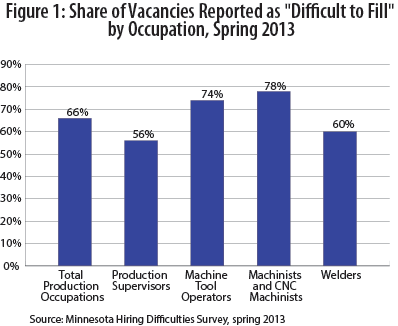
Turnover is one reason for persistent hiring difficulties: 84 percent of production vacancies experienced turnover during the last two years for reasons unrelated to retirements or internal job transfers. Supervisors had the lowest turnover at 54 percent, while machinists had the highest at 100 percent.
Most hiring difficulties were only temporary. In fact, 68 percent of hard-to-fill positions were filled within four months of the posting date. When employers were asked how satisfied they were with the qualifications of the people they hired, the response was "very satisfied" in 65 percent of the cases, "somewhat satisfied" in 20 percent of the cases, and "not satisfied" in only 15 percent of the cases.
Hiring Difficulties Survey Quick Facts
|
Hiring difficulties are not synonymous with skills gaps. When employers were asked to identify the causes of their hiring difficulties, only 14 percent of cases were attributed exclusively to the lack of skilled applicants for current vacancies. The majority of hiring difficulties (31 percent) were caused by a mix of skills mismatches and other reasons (see Figure 2). Demand conditions alone accounted for 26 percent of hiring difficulties, while 28 percent were attributed exclusively to candidates' lack of work ethic or interest in a manufacturing career. Lack of work ethic and motivation are not skills gaps, but they can make a candidate unattractive in a setting where everyone is expected to arrive on time and work as a team.1
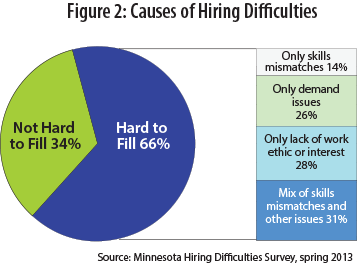
Another problem was not enough applicants: 70 percent of hard-to-fill positions attracted fewer than 10 applicants. Employers said low supply is a result of declining interest in skilled production as a career track. The following quotes from employers illustrate this point:
"Interest in welding has gone down. And we can train people on the job only if they have the interest in pursuing welding as a career."
"Not as many people choose this career. And it takes a while to become a qualified machinist, so even if you complete the right vocational degree, then you have got to come in as an apprentice somewhere and you've got to be willing to stay in the field and get educated."
"The colleges are just responding to demand from high school, and with no demand for machining, programming or setups, there is no incentive for the colleges to offer those classes."
The lack of long-term commitment in new hires discourages firms from offering on-the-job training and post-secondary institutions from offering more classes in these fields. It also leads to fierce competition among manufacturers for qualified candidates and some reluctance to invest in internal skills formation for fear of losing skilled workers to competitors.
When demand factors were cited as primary barriers in recruiting, undesirable geographic location topped the list followed by uncompetitive wages and inconvenient work shifts. These factors are often interrelated as qualified candidates are unwilling to work for firms located in low-wage regions, especially if working hours are long and inflexible. Here is how respondents described these challenges:
"It's a combination of location and compensation, because to induce a candidate to relocate you've got to offer them comparable wages to what they are making in their current location. Often they are in the Twin Cities, and we can't bring them in that high without offsetting our own compensation program."
"We are not competitive [in terms of wage]."
"The job is not that specialized. It's more about the work ethic, the willingness to work from 10 to 14 hours a day, the willingness to live in a small town and the low pay."
Failing to account for these factors may lead employers and policymakers to misdiagnose the problem of hiring difficulties as a lack of qualifications alone - skills gaps - and to prescribe policy responses that address the symptoms rather than the real causes of hiring difficulties.
When skills mismatches were cited as a problem alone or together with demand factors, the reasons mentioned were consistent with survey responses collected in 2012. Applicants have either inadequate hands-on training or inadequate experience. These gaps are best filled through employer-provided training, as the following quote illustrates:
"We are looking for a mixed skills set: good mechanical aptitude, physical energy, and the ability to set up and operate a multi-axis lathe. You can't come out of school and be able to run these machines. It's a skill usually built through mentorship programs in companies that stay current with technology. Some people can pick it up after three to five years, others after a decade."
The previous section looked at employer perceptions of the causes of hiring difficulties. In this section we analyze the impact of firm and job characteristics on hiring difficulties. Factors such as firm location, firm size and educational requirement of the vacancy have the strongest influence on the probability of a vacancy being hard to fill (see Table 1).
| Comparison of Hard-to-Fill and Not-Hard-to-Fill Vacancies by Firm and Job Characteristics | ||
|---|---|---|
| Factor | Categories | % Hard to fill |
| Firm Location | Metro Area | 35% |
| Greater Minnesota | 79% | |
| Firm Size | Small: Less than 50 employees | 76% |
| Medium: 50-249 employees | 68% | |
| Large: 250 or more employees | 41% | |
| Experience Requirements | No experience required | 64% |
| Experience of less than three years | 58% | |
| More than three years of experience | 79% | |
| Education Requirements | High School | 69% |
| Associate or Vocational | 64% | |
| Bachelor's | 35% | |
| Training Indicator | Yes, the firm offered training | 61% |
| No, the firm did not offer training | 82% | |
|
*Training is defined as any of the following: structured on-the-job training, apprenticeship or internship, off-the-job training and tuition reimbursement for classroom training. The model was able to correctly predict the presence (or absence) of a hiring difficulty in 89 percent of cases, with a Nagelkerke R Square of .602. The following variables were included in the model: region (metro versus Greater Minnesota), firm size, educational level, experience level, occupation, and an indicator of whether the firm offered structured training to new hires or incumbent workers over the last 12 months. |
||
|
Source: Minnesota Hiring Difficulties Survey, spring 2013 |
||
The influence of each factor is explained below.
Firm location: Seventy-nine percent of production vacancies in Greater Minnesota were hard to fill compared with 35 percent in the Twin Cities. Distance from the metro area and rural/urban divide alone do not explain this difference. As shown in Figure 3, central Minnesota - densely populated and closest to the Twin Cities - experienced significantly more hiring difficulties (90 percent) compared with remote northwestern Minnesota (52 percent). The explanation is probably that firms in central Minnesota experience competition from both local and Twin Cities manufacturers.
Firm size: Vacancies were much more likely to be hard-to-fill in small and medium-sized firms (fewer than 250 employees) compared with large firms (250 and over). Small manufacturing firms are clearly at a disadvantage compared with large firms when recruiting.
Delivery of training: Eighty-two percent of firms that did not offer structured training had difficulties filling production vacancies compared with 61 percent that did offer training. A possible explanation is that firms that lack the capacity to deliver training to new hires probably also lack the flexibility to hire inexperienced candidates.
Education and experience level: Hiring difficulties were much more common in vacancies requiring a high school degree (69 percent hard to fill) compared with those requiring post-secondary education. Only 29 percent of the high-school vacancies, however, were truly entry-level, requiring neither education nor experience (see Figure 4), while 71 percent required more than one year of related work experience at a minimum.
Expecting high-school educated external candidates to bring a mid-level skill set clearly presents a challenge for employers, especially after the disappearance of machine shop classes from K-12. This is one reason some firms are going back to a strategy of building skills and promoting from within as an alternative to hiring for mid-level skills. The decision to develop skills internally or buy from outside through new hires is often dictated by the tightness of the labor market.
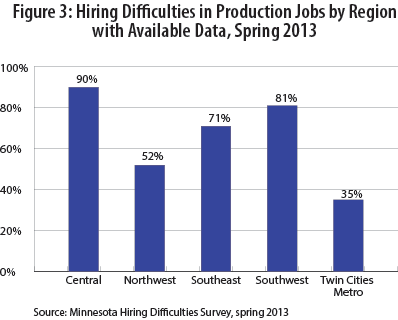
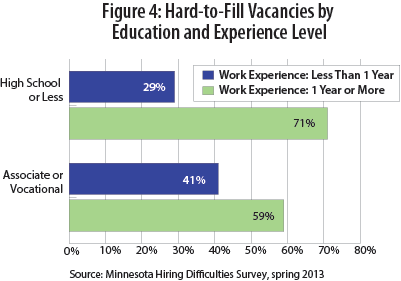
Figure 5 illustrates the actions taken by employers who reported difficulties filling production vacancies.
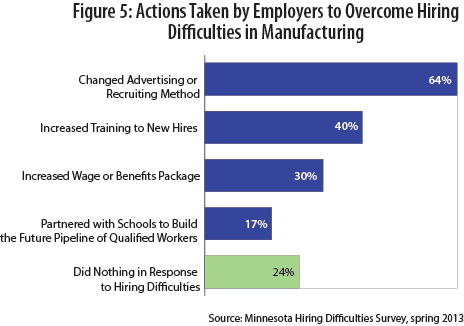
The most popular response, adopted in 64 percent of the cases, is changing advertising or recruiting methods, which is low cost and effective in the short term. The most remarkable survey finding is the high share of firms (40 percent) that increased training for new hires. As the labor market tightens and competition among firms for qualified workers increases, employers are clearly more willing to hire inexperienced candidates and address their skills gaps through training, indicating a shift from a "buying" to a "making" approach to skills.
Internal training often requires a change in roles and work practices that does not come without resistance. As one HR professional said:
"I am trying to convince the plant manager to train the supervisors better. They have the bad habit of providing some cursory training and throwing them out there. Sometimes training by 'trial by fire' is the way to go, but not necessarily. The supervisors become frustrated early because they don't know what they're doing and aren't sure how to get the help, and occasionally they'll leave. They also should not expect a recently promoted supervisor to supervise 100 people perfectly. We should give them tools they need to do their job well: classes, schooling, whatever."
In 30 percent of the cases, employers attempted to make their vacancy more attractive by raising the wage or improving benefits. This is indicative of employer awareness of the role demand factors play in causing hiring difficulties. In another 17 percent of cases, employers partnered with schools for curriculum development, internships or sponsorship programs to help students pay for schooling.
According to respondents, strategies that combine internal training and partnerships with colleges are particularly effective because they facilitate the transition from school to work and help build the future pipeline of qualified workers. The following are three of the many success stories that employers shared during the interviews:
"We have a successful internship program whereby we pay a generous portion of tuition for students, and they can work here part time and also go to school. Many of them end up working full time after they graduate, and that's how we get most of our machining positions filled."
"Last year this company had 120 percent turnover over the summer. This year we are at 35 percent thanks to better hiring standards followed by better training for new hires. We're one of the few companies willing to lower the experience requirements and train new hires as machine operators. We created an apprenticeship program through the local technical college. Students complete the two-year degree over four years while working for us full time and we pay for everything including their books."
"We partner with schools offering programs in machining and welding. Local manufacturers hold regular meetings to offer feedback on curriculum design."
In these and other cases, Minnesota employers and schools are developing innovative partnerships that are helping to strengthen the entire manufacturing sector.2
Thirty percent of firms reported no training needs for incumbent workers. Of the 70 percent that identified gaps in their current workforces, work-related experience was most often cited, consistent with the types of gaps cited in job candidates. Interestingly, respondents also emphasized the need for more cross-training rather than occupation-specific training. While post-secondary educational institutions have a role to play by providing multidisciplinary training, on-the-job training is the main path for developing a workforce that fits the needs of individual manufacturers.
What are employers doing to train their workforces? Figure 6 shows the types of training that employers reported delivering over the last 12 months.
To put these results in context, remember that full competency in machining, CNC (computer numerical control) machining, welding and machine operations is acquired through structured on-the-job training lasting from one month to one year. With that in mind, these relatively low frequencies for job training and apprenticeships may be the result of cuts in employer training budgets during the Great Recession when skilled labor was abundant and firms could still find high school graduates with machine-shop skills. Between 2012 and 2013, almost all surveyed firms had job shadowing or buddy schemes, with 17 percent relying exclusively on job shadowing to train new hires.3 The trend appears to be turning back toward an increase in structured on-the-job training in response to a tightening labor market.
Figure 6 also shows that 40 percent of firms offered tuition reimbursement or paid classroom training. Employers value post-secondary training, both to upgrade the skills of their workers and to attract candidates who otherwise could not afford to earn a degree.
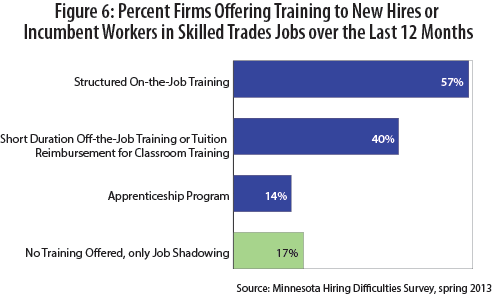
Manufacturers face unprecedented challenges in filling skilled production positions, including competition from other firms, declining interest in manufacturing careers among young people, unattractive firm locations and work shifts, uncompetitive wages and skills gaps.
Minnesota employers are investing in solutions to remove some of these barriers. Demand factors are more often acknowledged and addressed, and firms are shifting from a strategy of buying skills from outside to building skills by training incumbent and new workers. Investing in internal skills, either in partnership or in-house, will pay off in the long term. Employer-driven initiatives and policies that favor business-education collaborations tailored to the unique needs of a region and industry are critical to the future competitiveness of Minnesota's manufacturers.
1One respondent expressed this as follows: "Younger generations seem to have a sense of entitlement. When they're asked to do something different, they expect to be paid more. But in our firm everybody, even those who are working in the office, can be pulled to the shop at some time. Everything is your job if you get compensated. That's why we ended up hiring someone older, who had none of the technical skills and qualifications required to work as a CNC operator. It's pretty much just the work ethic that got him the job."
2One of the pioneers is Skills Right Now, a program in machine-tool technology that leads to industry-recognized credentials through the National Institute of Metalworking Skills. It features a semester of paid internships alternating with a semester of in-class instruction.
3Job shadowing involves pairing the new hire with an experienced worker who is not officially tasked with training. On-the-job training is an intensive, longer-term approach that establishes a trainer-trainee relationship to build a broad set of competencies.